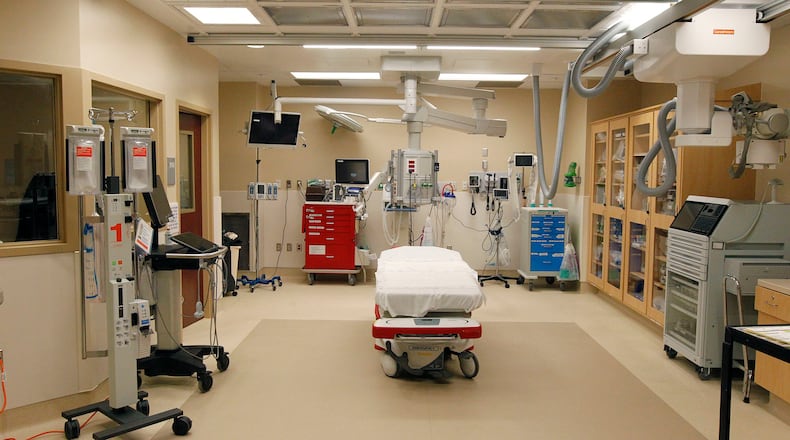Hospitals are not only health care providers but also among the biggest businesses and largest employers in the Miami Valley, and the economic health of the region hinges on their stability.
With payments still coming in and expenses still being settled, it will take months into 2021 to know local hospitals’ 2020 margins. It is also not clear if more stimulus money could come to hospitals.
In the spring, Ohio hospitals expected to lose an estimated $1.27 billion a month due to the coronavirus, with 80% of that due to postponing electives procedures, according to the Ohio Hospital Association at the time.
Hospitals furloughed some staff, though started bringing workers back in the summer. Then as 2020 progressed, people who have met their deductible and people who want procedures previously postponed both wanted to come in.
“We’ve been digging out of that two-month cancellation, it really has taken all of the year,” Premier Health CEO Mary Boosalis said.
Credit: Jim Noelker
Credit: Jim Noelker
Other expenses remain high for hospitals this year compared to other years. Hospitals all competing for a limited pool of travel agency staff has led to an increase in travel wages. Personal protective equipment is more available than the spring shortage but prices are still up and usage is still high.
“It’s still much more expensive for masks than it was pre-pandemic, and we use about four times as many masks on a daily basis. We use about 9,000 masks a day across our health system, which is about four times more than what we use before the pandemic,” said Craig Ganger, Premier Health chief finance officer.
Patients with COVID-19 on average stay in the hospital longer than the average patient -- sometimes for over a month -- but, depending on the insurance, the hospital might get a lump payment for all charges from admission to discharge.
So it’s more expensive to provide the labor-intensive care for a severely ill COVID-19 patient, but that doesn’t necessarily mean more money for the hospital.
“I‘ve run into people virtually, and publicly, and when they see how busy we are with just the volume they assume we’re making money hand over fist,” Boosalis said. “But COVID is not a money making deal. We’re going to care for you. That’s our mission. But don’t buy into this idea that we’re going to make a lot of money.”
Leading up to the pandemic, local hospitals were coming off a strongly profitable year, said Allan Baumgarten, an independent analyst who authored the Ohio Health Market Review 2020, who every two years takes a deep dive into hospital financial public records.
Hospitals in the Cincinnati/Northern Kentucky/Dayton region had combined net income of $1.309 billion in 2019 (11.4% of net patient revenues), up from $791.6 million in 2018. For the region, Premier Health was the most profitable system, while Cincinnati Children’s, Christ and the Kettering Health Network hospitals reported the strongest net income, according to Baumgarten’s calculations.
Credit: Jim Noelker
Credit: Jim Noelker
“Based on 2019 data, hospital systems across the state enjoyed stronger profitability and continue to pursue growth through new construction and acquisitions,” Baumgarten said.
Baumgarten also noted that the stock market has done well, so hospitals’ investments funds have also likely did well in 2020.
Hospitals also received money from the CARES Act. When the Dayton Daily News reviewed the HHS Provider Relief Fund allocation database, which were last updated Jan. 21, Miami Valley Hospital is listed having received $64.7 million. Kettering Medical Center is listed receiving $17 million.
Michael Mewhirter, CFO at Kettering Health Network, said in a written statement to questions about how the health system is financially doing that when elective procedures were suspended in March, the network saw a significant decline in patient volume. Those procedures are an essential and important piece of any health care system’s operations and finances.
“At the same time, people in the community were concerned about coming to health care facilities, putting off appointments and even delaying seeking care in an emergency,” Mewhirter said.
In a credit rating issued Jan. 11, Moody’s analysts said Kettering Health “will likely achieve greater than breakeven operating margin budgeted for fiscal 2020 following strong second half performance” though said its operating cash flow margins will likely remain below historically higher levels.
Ohio Medicaid enrollment is up 11% since February 2020, reflecting the struggling economy and job losses. Medicaid pays hospitals less for services than employer-sponsored insurance does. There are also more uninsured people or families financially struggling with the economy.
“It’s anticipated that’s going to be a growing challenge across the industry in this coming year, and something that will keep a close eye on. It’s not something that we’ve seen in mass at this point, in terms of non-Medicaid patients having a struggle to pay their bills, but it’s something that will definitely be keeping a close eye on here,” Ganger said.
About the Author



